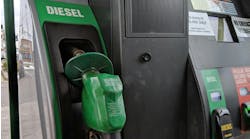While oil costs may push higher, fuel costs currently down
The week of August 5, the U.S. Energy Information Administration found that despite conflict in the Middle East and the threat of storms, gas and diesel costs across the U.S. have remained largely flat, often dipping a few cents in every region. Currently, the U.S. diesel fuel price average is $3.755, 1 cent lower than last week and 48 cents lower than this time last year. The rest of the country followed suit in almost every region at a rate of less than a cent up to 3 cents.
The only region that did not see a price drop was the Midwest, where diesel prices increased by a negligible 0.002 cents up to $3.729 per gallon. Otherwise, price drops across the country were minimal; most areas, including California and the West Coast, the East Coast, and the Rocky Mountain regions, saw diesel prices fall by 1 cent. This placed the East Coast at $3.830 per gallon, the Rocky Mountain region at $3.702 per gallon, the West Coast overall at $4.356, and California at $4.821 for diesel prices. In comparison, the Gulf Coast saw the largest price drop of 3 cents to $3.436 for diesel fuel, making it the cheapest region to purchase diesel, while California is the most expensive.
The AAA motor club’s numbers for diesel prices are only 3 cents more expensive than EIA’s national average at $3.788. This price is also 3 cents lower than last week’s average of $3.810 and 38 cents lower than last year's AAA’s estimate.
See also: Diesel prices still dropping, avg. $3.76/gal, gas up to $3.484/gal
Gas prices drop, U.S. average $3.44/gal.
Like diesel costs, gasoline prices dropped across much of the nation, according to the EIA, even if at a similarly marginal rate. The nationwide gas average is currently at $3.448, down 3 cents from a week ago and down 38 cents from this time last year. Otherwise, gas prices varied from 0-8 cents.
The only place gas prices rose was in the Rocky Mountain Region, where gas costs rose 4 cents to $3.435. But for the rest of the country, prices dropped a full 8 cents along the Gulf Coast to $3.010, 4 cents in the Midwest to $3.428, 3 cents along the West Coast without California to $3.779, and 2 cents along the East Coast and West Coast overall to $3.375 and $4.080, respectively.
The Gulf Coast still has the cheapest gas price at $3.010, while California has the highest price at $4.355.
The AAA’s estimate is once again 3 cents higher than the EIA’s at $3.472 per gallon and is once again 3 cents lower than last week’s prices. While this flattening curve has been helpful for drivers, both the motor club and Breakthrough chief economist Matt Muenster warned that weather events and geopolitics have the potential to push prices higher.
“The oil market is volatile, and the threat of a hurricane impacting production and refining will certainly grab its attention,” said Andrew Gross, AAA spokesperson. “Add in the rising tensions in the Middle East, and oil prices are poised to push higher.”
“I think that our past experiences have shown that if a strong enough storm arrives on the Texas Gulf Coast and is disruptive in places like Corpus Christi, Houston, and even into southern Louisiana, then we will have impacts to the refinery industry, and we will have price consequences that result from that,” Muenster agreed.
He explained that this would be true regardless of whether refineries needed to shut down because of damage or merely if their crews needed to be evacuated. “Like with Hurricane Harvey, we saw the worst-case scenario. There was damage but also tremendous flooding, and it took an extended period to recover that refinery utilization. It can take months to recover.”





